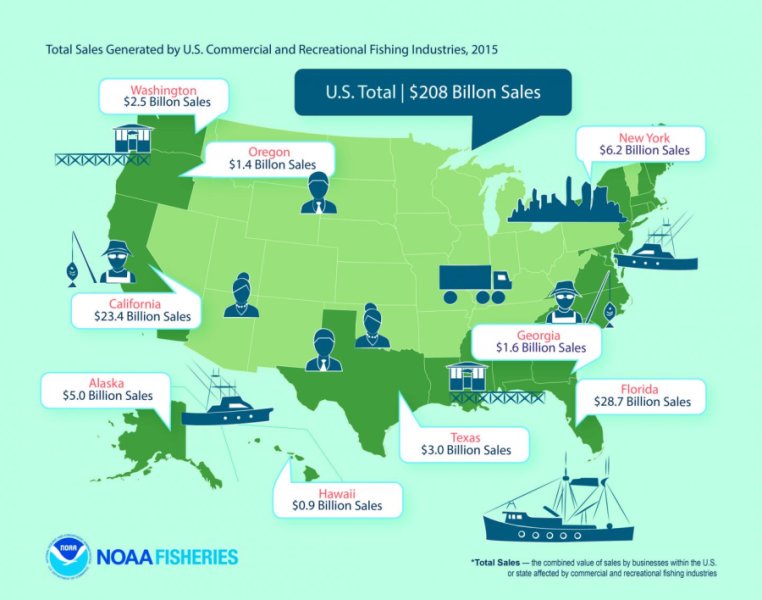According to NOAA U.S. Fishing Generated Over $200 Billion in Sales and Rebuilt Two Fish Stocks
OutdoorHub Reporters 05.15.17

The following is a press release from NOAA (National Oceanic and Atmospheric Association):
U.S. commercial and recreational fishing generated $208 billion in sales, contributed $97 billion to the gross domestic product, and supported 1.6 million full – and part-time jobs in 2015 – above the five year average, according to NOAA’s Fisheries Economics of the United States report released today.
Also out today, the Annual Report to Congress on the Status of U.S. Fisheries shows that the number of domestic fish stocks listed as overfished or subject to overfishing remain near all-time lows, with two new stocks rebuilt in 2016.
The reports highlight the collaborative role of NOAA Fisheries and many partners in making continued progress towards ending overfishing, rebuilding stocks, and realizing significant benefits to the U.S. economy.
“U.S. fisheries are big business,” said Samuel Rauch, acting assistant administrator for NOAA Fisheries. “Sustainable management of our nation’s fisheries, supported by sound science, opens up economic opportunities to Americans along the supply chain — from buying bait at a local marina to enjoying a seafood dinner.”
The U.S commercial fishing and seafood industry (including imports) generated $144 billion in sales in 2015, a 6% decline from the previous year, and supported 1.2 million jobs, a 15% decline from 2014, although this is still above the 5 year average. Factors such as the “warm blob,” marine toxins, and El Nino affected the Pacific marine environment in 2015, and West Coast fishermen saw lower landings and revenue for several key commercial species.
Market forces affected fisheries in other regions, such as in the Gulf of Mexico, where revenue for shrimp landings decreased due to high inventories, dampening prices for both domestic harvest and imports. Seafood imports were also lower in 2015 — $1.4 billion less than in 2014.
Saltwater angling generated $63 billion in sales across the economy in 2015, up 5% from 2014. Job impacts in the marine recreational fishing industry remained steady from 2014 at 439,000 jobs. Mississippi, Connecticut, South Carolina, Washington, and Alaska had the greatest recreational fishing sector job growth in 2015.
In 2016, U.S. fisheries continued to rebuild, with the number of stocks on the overfishing and overfished lists remaining near all-time lows. Four stocks came off the overfishing list, while six stocks were added to the overfishing list. There were no changes to the list of overfished stocks in 2016. Two additional stocks – barndoor skate in Georges Bank/Southern New England and albacore in the North Atlantic – were rebuilt in 2016, bringing the total stocks rebuilt since 2000 to 41.
A stock is on the overfishing list when the catch rate is too high. A stock is on the overfished list when the population size of a stock is too low, whether because of fishing or other causes, such as environmental changes.
“These reports show that the U.S. is on the right track when it comes to sustainably managing our fisheries,” said Rauch. “Rebuilding and keeping stocks at sustainable levels will help us address the growing challenge of increasing our nation’s seafood supply and keep us competitive in a global marketplace.”
View the 2015 Fisheries Economics of the United States and 2016 Status of U.S. Fisheries reports.
NOAA’s mission is to understand and predict changes in the Earth’s environment, from the depths of the ocean to the surface of the sun, and to conserve and manage our coastal and marine resources. Join us on Facebook, Twitter and our other social media channels.


